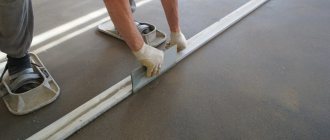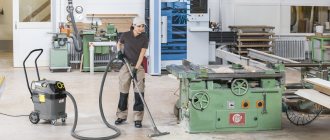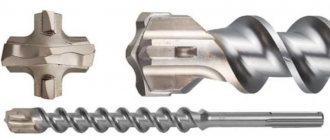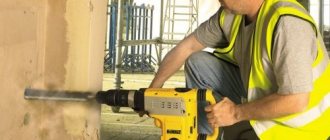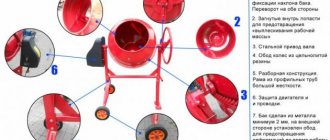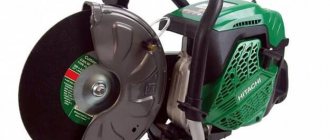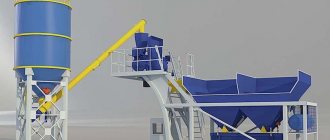Construction mixers are widely used on small and large construction sites.
The unit greatly facilitates the process of mixing various building mixtures to a homogeneous mass with uniform density, and allows you to quickly “refresh” stagnant compositions.
What to look for when choosing a construction mixer, which models are the best today, we will consider in this selection.
Page navigation:
Criteria for choosing a construction mixer
Reference! The construction mixer is structurally similar to a conventional drill, but has a number of technical solutions that increase the service life of its working units.
This is, first of all, a more powerful and durable engine, a maximally reinforced gearbox, durable brushes, lower gearing and high torque.
When choosing a construction mixer, consider the following:
- Power consumption. The higher this parameter, the greater the load the mixer can withstand. Devices with a 1–2 kW motor are suitable for mixing viscous materials and preparing heavy mixtures. Including when working with large volumes of compounds and active use of the tool. Devices with a power of up to 1 kW are recommended for use when performing relatively small finishing work.
- Torque. The torque value shows how well the motor transmits force to the whisk. This parameter, along with power, is associated with the performance of the unit. The higher it is, the more effective the mixing process will be.
- Rotational speed. A construction mixer does not require high engine speeds. Most models operate at 500-700 rpm. Meanwhile, the passport data indicates the maximum idle speed, which can drop under good load.
- Number of speeds. Construction mixers have from 1 to 3 speeds depending on the model. Downshifting changes the rpm down and the torque up and vice versa, which is useful for various tasks.
- Type of food. Construction mixers are mainly connected to the electrical network. It is convenient if the network cable is long enough - 3-4 meters. Rechargeable models receive energy from a rechargeable battery and are indispensable in sites without power supply.
- Useful additions. Adjustable speed allows you to easily configure the tool to work with different materials. The reverse system ensures a change in the direction of rotation of the whisk. Smooth start-up protects the operator from splashing out of the mixed solution and knocking out circuit breakers in the electrical network. Overload protection reduces engine speed when overheating to an acceptable level. Locking the start button allows you to lock the trigger in the pressed position while operating the tool.
Mixing concrete with an electric mixer: features and operating techniques
Everyone who builds a house on their own, without hired workers, wants to simplify the task for themselves. For example, use a concrete mixer to mix concrete. A high-quality concrete mixer is not a cheap pleasure. Many will say that its price will be recouped during the construction season. But I want to save money and not break my back mixing concrete with a shovel. This is where the idea comes - to use an electric mixer to mix the solution of sand, cement and crushed stone.
OtherNickFORUMHOUSE Member
I saw a video on YouTube - a man, alone, using a two-spindle mixer, mixed concrete and poured a strip foundation in two days. I thought maybe this was an advertisement for a tool? The builder claims that it is more convenient to knead with a mixer than with a concrete mixer. The question is relevant for me. I mixed concrete in a concrete mixer. It's hard for one. We have to lift buckets. Load the pear. I rented a concrete mixer. There is nowhere to store yours. And with a mixer you can knead the concrete right at the pouring site. It weighs a little. Tell me, is this realistic if you knead small volumes? Maybe someone has already used a mixer? Will the tool break?
beutiflet FORUMHOUSE Member
I think tools should be used strictly for their intended purpose. A mixer is needed to mix plaster and adhesive mixtures, and a concrete mixer is needed for concrete. The weak point of the mixer is the attachments. On heavy concrete with crushed stone, the rim's blades may come off or it will bend.
Just Grandfather FORUMHOUSE Member
Compare the price of a normal mixer and a concrete mixer. The difference is small. It seems to me that health is more important! Using a concrete mixer, you can work together. One carries sand and crushed stone, the second monitors the batch. You work alone as a mixer. Oh, what strength is needed for this. You'll get tired quickly. My concrete mixer is already 10 years old, and it has long since paid for itself.
Now let’s listen to the opinion of those FORUMHOUSE participants who actually kneaded concrete with a mixer.
Bath1
I poured the strip foundation for the fence using a mixer. Tape length 25 m. Section – 200x300 mm. I also concreted a 5 m lintel under the gate and wicket. From my own experience, I will say that you get more tired not from working with a mixer, but from throwing sand, cement and crushed stone, and pulling out concrete. But you also need to throw ingredients into the concrete mixer. It still needs to be washed later, but the mixer spun in the water and went home. Of course, I wouldn’t dare to pour a foundation for a house with a mixer, but for small volumes, it’s quite a suitable option.
The Bath1 mixture was prepared as follows:
- First he mixed dry sand and cement.
- Then he added water. The consistency of the mixture is like sour cream.
- Then he threw in 3 buckets of crushed stone. Stirred the mixture. Then I added another 1.5 buckets of crushed stone.
CartmanSr
I mixed concrete in a cast iron bath with a two-spindle mixer. Two spindles are better than one. The torque is damped and, in the case of a wedge, will not wrap around the tool. I threw cement, sand, crushed stone of fraction 5-20. I stirred for ten minutes and 200 liters of the mixture was ready. I won’t say it’s easy, but it’s not hard either. The crushed stone between the augers did not jam. The tool didn't break.
OtherNick
Briefly speaking. I listened to everyone and also decided to knead concrete with a mixer. I'm reporting. I mixed about 1.5 cubic meters of concrete for the columnar foundation. The mixture is hard. Proportions: 1 part cement, 3 parts sand, 4 parts crushed stone and 0.75 liters of water. Mixed in a 100 liter trough. I made 5-7 batches per day. I couldn't do it anymore. Your arms, especially your hands, get very tired. I’m not saying that I’m weak, but the twisting load on my joints is decent. Crushed stone of fraction 5-20 did not get stuck between the rims. The instrument also held up. Verdict: the method is suitable for small volumes for one-time work.
I wonder if it is possible to fill larger volumes using a mixer? The construction experience of FORUMHOUSE users says: “Yes.”
Veter753
My assistants and I poured 4 cubes of concrete with a mixer. There were 4 people working - two men and two women. The women put cement and enriched sand and gravel mixture into buckets. One man is kneading. The second one carries the buckets, and then the two of us dump the mixture into the formwork. Mix proportions: 1 bucket of cement, 1 bucket of sand, 3 buckets of OPGS, 0.7 buckets of water. In total, we made 115 batches with smoke breaks. It was still raining. The old tub was also leaking. They repaired it. As a result: started at 10 am, finished at eleven o'clock in the evening. Then they added a little more in the morning. The back gets tired, but if you get used to holding the mixer without bending over, with your legs spread wide apart, there is no fatigue. If they started to interfere at 7 am, there were 3 men, not women, it didn’t rain, and the tub didn’t leak, then I think they would have finished it before 6 pm. The mixer kneads the mixture quickly. The main fatigue comes from dragging buckets with OPGS through the formwork and lifting the bucket to the level of the formwork to dump the concrete.
Veter753 tips for using a mixer when mixing concrete:
- First load water, cement and sand.
- Knead the mixture until it becomes sour cream.
- Add 2 buckets of OPGS.
- Stir the mixture until it is a uniform gray color.
- Add another bucket of OPGS.
- Stir evenly again.
The concrete is ready.
If you keep the mixer in one place, it will not mix the mixture, because it will mix in one place. To mix the concrete well, you need to move the mixer in a circle, and zigzag, left and right.
Valeron 1983
The two of us, in 4 days, poured 17 cubic meters of concrete with a mixer. Monolithic slab. Concrete was mixed in a bathtub. They placed it on the reinforcement inside the formwork and turned it over after each batch. We were tired, of course, but we would have been tired with a concrete mixer too. I liked working as a mixer. It gets in the way quickly. He doesn’t twist his arms, his back doesn’t hurt, even though they kneaded with a single-spindle tool. You get more tired of carrying sand, cement and crushed stone.
The best models in terms of price/quality ratio
Affordable and highly powerful devices do an excellent job of mixing mastics, heavy solutions, and dry mixes.
Rating of the TOP 4 best construction mixers for concrete and dry mixes in terms of price and quality ratio.
ELITECH MS 1600/2ED 1600 W
The high-quality construction mixer ELITECH MC 1600/2ED, equipped with a 1.6 kW engine and two effective nozzles, will ensure rapid mixing of mixtures and finishing materials of various densities.
The unit is equipped with two speed modes, an electronic speed control system, and a quick-release chuck for quickly changing equipment.
The device is mounted in an ergonomic housing with two handles, is characterized by the ability to quickly replace motor brushes and a high torque value (50 Nm).
The product is connected to the network with a 3 meter long cable.
The delivery set includes 2 whisks.
Specifications:
- number of speeds - 2;
- power type - mains;
- idle speed - 790 rpm;
- power consumption - 1.6 kW;
- functionality - speed controller, start blocking;
- device weight - 7.6 kg.
Advantages
- high power;
- speed adjustment;
- body ergonomics;
- long power cable.
Flaws
- high noise level;
- impressive dimensions;
- heavy weight.
Interskol KM-60/1000E 1050 W
The Interskol KM-60/1000E construction mixer with a power of 1.05 kW is an affordable professional power tool for preparing mixtures and solutions during construction and repair work.
The model is equipped with a powerful engine, the gearbox housing is made of especially durable aluminum.
The included universal auger makes it possible to effectively mix the vast majority of construction compounds.
The presented mixer is equipped with a speed control system, a two-speed speed unit, and a start button lock.
The ergonomic design and arrangement of the handles ensures no discomfort during operation.
The torque value of the device is 53 Nm.
Specifications:
- number of speeds - 2;
- power type - mains;
- idle speed - 850 rpm;
- power consumption - 1.05 kW;
- functionality - speed controller, start blocking;
- device weight - 4.3 kg.
Advantages
- good power;
- presence of speed control;
- there is a locking power button;
- convenient placement in the hands;
- rich equipment.
Flaws
- decent noise level;
- not ideal build quality;
- inconvenient location of the speed controller.
BISON MR-1050-1 1050 W
The construction mixer BISON MR-1050-1 with a power of 1050 W will ensure high-quality and fast preparation of all kinds of mixtures, followed by giving them a uniform consistency.
This model is equipped with an M14 cartridge, a long metal nozzle, and has two operating speeds.
The maximum speed of the operating device is 760 units per minute.
The mixer receives energy from a 220 volt power supply.
The design is complemented by an ergonomic double-sided handle with a rubberized coating. The product is equipped with two keys for maintenance and repair.
Specifications:
- number of speeds - 2;
- power type - mains;
- idle speed - 700 rpm;
- power consumption - 1.05 kW;
- functionality - speed controller, start blocking;
- device weight - 4.7 kg.
Advantages
- affordable price tag;
- high-quality assembly;
- sufficient power;
- ergonomics of the case.
Flaws
- no case included;
- the whisk is not of the best quality;
- high noise level.
VORTEX SM-1200E 1200 W, orange
Affordable high-quality equipment VORTEX SM-1200E 1.2 kW in a stylish and practical orange casing is the ideal combination of high reliability and ergonomic design.
The model is equipped with a powerful and productive electric motor, a single-speed gearbox, and a button that locks in the on position.
The mixer is equipped with an M14 chuck, compatible with most threaded attachments.
The device boasts a high torque of 95 Nm.
The device is connected to the network using a two-meter cord with a plug. The product is equipped with 2 open-end wrenches, an extension, and a nozzle.
Specifications:
- number of speeds - 1;
- power type - mains;
- idle speed - 650 rpm;
- power consumption - 1.2 kW;
- functionality - speed regulator, start lock, additional handle;
- device weight - 5.5 kg.
Advantages
- low cost;
- high power;
- functionality at the level;
- relatively light weight;
- decent equipment.
Flaws
- short network cable;
- just one speed.
The best inexpensive models
The presented mixers are an ideal solution for small volumes of work, home craftsmen who have started renovation or construction of a country house.
Review of the best inexpensive hand-held construction mixers for mixing construction mixtures.
Fiolent MD1-11E 1100 W
The universal-purpose construction mixer Fiolent MD1-11E with a 1.1 kW electric motor is a practical tool for the production of mortars, paints, glue, dry concrete and other compositions.
The model can also be used as a drill for drilling holes in various materials.
The device is equipped with an M14 cartridge, an adapter for installing the cartridge, an ergonomic additional handle, and a soft start system.
Maximum efficiency of the mixing process is ensured by the speed controller.
The maximum torque value of the mixer approaches 85 Nm.
Specifications:
- number of speeds - 1;
- power type - mains;
- idle speed - 600 rpm;
- power consumption - 1.1 kW;
- functionality - additional handle, speed regulator, start lock;
- device weight - 4.7 kg.
Advantages
- high power;
- relatively light weight;
- presence of an additional handle;
- good torque.
Flaws
- not rich equipment;
- hard, short cord;
- lack of reverse.
Instar EDM 25016 1600 W
The productive and affordable mixer Instar EDM 25016, equipped with a 1.6 kW engine, will provide high-quality mixing of dry and liquid components during construction or finishing work.
The device is characterized by excellent performance and high torque.
The unit easily copes with the densest mixtures.
The model has two operating speeds, an electronic speed control system, and receives energy from a network with a voltage of 220 volts and a frequency of 50 Hz.
The product is equipped with a 2-speed gearbox, a whisk, spare carbon brushes, and keys for changing equipment.
Specifications:
- number of speeds - 2;
- power type - mains;
- idle speed - 650 rpm;
- power consumption - 1.6 kW;
- functionality - speed controller, start blocking;
- device weight - 5 kg.
Advantages
- high power;
- ergonomic design;
- presence of soft start;
- high-quality whisk;
- two-speed mode.
Flaws
- stepwise speed control;
- high noise level;
- heavy weight.
Status MX1000 850 W
The construction mixer Status MX1000 with a power of 850 W will allow you to perform high-quality and fast mixing of liquid and semi-liquid compositions - paints, mortars, glue, plaster and similar materials.
The unit is equipped with an M14 cartridge, an electronic engine speed control system, and a single-speed gearbox.
The product is equipped with ergonomic handles and the ability to lock the start button during operation.
A service cover is provided for quick access to the motor carbon brushes.
The delivery set includes an additional handle.
Specifications:
- number of speeds - 1;
- power type - mains;
- idle speed - 600 rpm;
- power consumption - 0.85 kW;
- functionality - additional handle, speed regulator, start lock;
- device weight - 2.4 kg.
Advantages
- compactness;
- sufficient rotation speed;
- small weight of the product;
- functionality.
Flaws
- the additional handle is not of the best quality;
- low power;
- one speed.
What types of mixers are there?
Drill - mixer
An electric mixer runs on mains power or batteries. There are two types of devices: drill mixer and mixer. The first option is a low-speed hammerless drill equipped with a key or keyless chuck for fixing the drill and whisk (mixer). The shafts of some models are equipped with a thread onto which a cartridge or stirrer can be screwed. The weight of this type of device does not exceed 4 kg. Too much for a drill. Strictly speaking, as a drill, it is unlikely to please anyone. You can drill a couple or three holes with it if you don’t have a normal drill or hammer drill at hand.
The main purpose of the tool is a mixer. It is better not to use it for mixing concrete or not to use it too often and for small-volume batches. It does an excellent job of mixing cement and lime mortars, screeds or adhesives for tiling walls and floors with ceramic tiles. Models from some manufacturers of drill mixers include a case, which is very convenient for storing the tool. Perhaps the main advantage of devices of this type is that they are inexpensive. If you are choosing a tool for your home, this is the most suitable option.
Construction mixer
A tool intended only for mixing construction mixtures. Depending on the power consumption, the number of revolutions per minute, torque, and the number of spindles (one or two), mixers are distinguished for the preparation of moving or viscous compositions. Some models successfully replace a small concrete mixer, since they are almost as good as it in performance and are free from some of the inconveniences associated with its use:
- The concrete mixer has solid dimensions and weight. It requires two people to move it.
- Upon completion of work, the tool must be stored somewhere and preferably under lock and key. Finding a place to store even the smallest concrete mixer is not easy.
- At the end of the working day, the mixer drum must be cleaned of any remaining mortar or concrete, otherwise the device will very soon fail. To clean the drum you will need a lot of water and a place to drain this water.
The mixer is free from all of the listed disadvantages. It doesn't need much storage space. One worker can move it anywhere on a construction site, including multi-story buildings, without much effort. There is no need to pour buckets of water to clean the whisk. It is enough to “spin” it in a bucket of water in a timely manner and wipe it with a rag.
Which mixer to choose
Depending on the power consumption, there are three types of mixers:
- For the preparation of low-viscosity mobile solutions, plaster compositions, and paints and varnishes, devices with a power consumption of 600–1000 W, a rotation speed of 500 to 900 rpm, with a single-speed electric motor and one spindle are sufficient. An example of such a tool is the Fiolent MD1 - 11E model.
- For heavier mixtures - devices with a capacity from 1000 to 1800. As a rule, these are devices with a two-speed gearbox. Switching modes (speeds) is carried out by a translator located on the product body. At first speed – from 130 to 450 rpm, they work with low-moving, viscous mixtures and concrete. The second speed – from 450 to 1050 rpm, ensures high-quality mixing of painting, plaster, putty and adhesive compositions. Two spindles rotating the nozzles in opposite directions ensure high productivity and uniformity of the composition. The Elitech 1600/2ED model is endowed with these parameters.
- Mixers with a power of 1800 W or more, with a two or three speed gearbox, are considered professional equipment. They are used to prepare mixtures of any viscosity with various fillers, including for mixing concrete. Professional mixers can withstand intense loads for a long time without failures or breakdowns. They are quite expensive and it is not practical to purchase them for household use. An example of one of the professional models is the Bosch GRW 18 – 2E Professional.
Criteria for choosing a construction mixer
- Work intensity. For professional use, it is better to choose powerful two- or three-speed devices, preferably from well-known brands known for the high quality of their products. They are more expensive, but more productive and reliable. The costs will be repaid by long-term intensive use.
- Characteristics of mixed compositions. Two or three-speed devices with a high rotation speed of the mixer and a power of 1800 W are more advisable to use if the team often works with heavy mortars and concrete. Devices with a power of up to 1000 W and a nozzle rotation speed of up to 600 rpm are more profitable to use for the preparation of finishing compositions: plaster mortars and putties, adhesives and paints. If an organization carries out general construction and finishing work, it is better to have tools of different types and power on hand.
- For domestic use, everyone chooses the equipment themselves, taking into account the upcoming nature and volume of work. Considering that the intensity of work of a household tool is an order of magnitude lower than that of a professional one, it is better to choose semi-professional devices. They are affordable and the possibilities are quite wide.
What else should you pay attention to?
It will not be possible to prepare high-quality solutions for various purposes with one type of whisk. The fillers for each composition are different. Some, heavy ones, tend to sink to the bottom of the container. Others, light ones, rise up. There are mixtures in which the presence of air bubbles can reduce the quality of finishing work. For each type of composition, certain types of nozzles with different blades have been developed.
Straight blades.
Such whisks are used for preparing adhesive compositions. The presence of air bubbles and foreign objects, even the smallest in size, is unacceptable. A nozzle with straight blades does an excellent job of removing air bubbles from the batch.
Spiral blades.
The most common attachments. Several spirals are wound from the lower edge of the rod, bounded at the top by a ring. There are spirals of left and right rotation. A nozzle rotating clockwise is used to prepare starting and finishing putty, since during rotation it presses the composition down. Mixers with a left-handed spiral are used for preparing cement-sand mortars and concrete. They lift heavy ingredients up, preventing them from settling to the bottom of the container. Double-spindle mixers use right- and left-hand rotation beaters.
Oppositely directed blades are used for mixing paint and varnish mixtures. The material is liquid and splashes at high stirrer speeds. The lower spiral is busy mixing the composition, and the upper one “presses the liquid mixture down, preventing splashes from scattering.
Nozzles for heavy compounds
To mix sand with crushed stone or gravel, you need a particularly durable mixer with blades of a certain configuration. A whisk for paint or putty will not last long in such conditions.
The homogeneity of the material and the performance of the device depend on the correct choice of nozzle. You should not choose stainless steel whisks with anti-corrosion coatings. This is money thrown away. Any coating will come off after a few kneads, and stainless steel is no stronger than regular steel. Choose a durable whisk, taking into account the nature of the mixtures being mixed. It is better to always have different types of attachments.
DIY mixer attachment
If your income does not allow you to splurge on the purchase of a mixer, or the volume of proposed work is so small that such costs are irrational, you can build a nozzle for mixing light solutions with your own hands. If you have a small welding machine and manual arc welding skills, this will not be difficult. It is enough to select a steel rod with a diameter of 5 - 8 mm, roll up a ring no more than 12 mm in diameter, weld three rods of the same diameter to it on three sides so that you get a cone about 100 mm high. A rod 40–60 cm long and 8 mm in cross section is welded to the top of the cone. The free end of the rod is ground to give it the shape of a triangle in cross-section, to securely fix the homemade mixer in the jaw chuck of a household drill or hammer drill. The nozzle is ready.
You can do without electric welding. You will need an M 8 mm pin and three metal plates. The length of the plates is selected depending on the diameter of the container for mixing the solution. A hole with a diameter of 8 mm is drilled in the center of each plate. Then, with the same diameter, another pair of holes is drilled to the right and left of the central ones. A pin is threaded through the central holes of the plates. Each plate is fixed to the rod with M8 nuts at the top and bottom. The shank of the improvised attachment is ground to fit the cam chuck of the drill (the cross-section should be a triangle). The nozzle is ready.
Which brand of mixer is better to buy?
The number of manufacturers of construction mixers is difficult to count. To the numerous European, Asian and American brands, no less numerous manufacturers from the countries of the former USSR have been added. Let's look at the best manufacturers who have managed to establish themselves by producing high-quality instruments from different parts of the world.
Bosch
The oldest and one of the most famous German companies producing high-quality household appliances. Engineer and inventor Robert Bosch founded it in 1886. Currently, the Bosch group of companies is one of the world's ten largest manufacturers of household and professional electrical equipment and tools.
Interesting! Robert Bosch was the first to switch his workers to an 8-hour workday and a two-shift schedule, believing that only a well-rested worker could produce high-quality products. His motto: “It is better to lose money than the trust of customers.”
Hitachi
One of the world's largest electrical goods companies. Its product range includes over 200,000 units. Hitachi is one of the world leaders in the production of information technology equipment, household electrical appliances and electronics. Founded at the beginning of the 20th century in Tokyo.
Interesting! Hitachi, translated from Japanese - dawn. Thus, according to the founder of the company, its activities are aimed at improving the quality of life of customers with the help of high-quality Hitachi equipment.
Makita
Another Japanese company leading in the production of household and professional power tools. Founded at the beginning of the last century. The company produces popular models of high-quality professional and household tools with electric and gasoline-powered drives.
Stanley
The company, founded in the USA in 1843, originally produced bolts and bolts. Over the 150 years of its existence, the company has grown into one of the most powerful manufacturers of household and professional power tools, famous for its reliability and wear resistance. The popularity of Stanley models is due to their performance and excellent wear resistance.
DeWalt
The owner of the brand is the American concern Stanley Black & Decker. The company was founded in 1924. Since 1994, it has been producing cordless power tools and producing the most powerful cordless drill at that time - a 14 V impact wrench. Currently, it is a leader in the market of power tools powered by batteries and brushless motors. An example of this is the DeWALT DCD 240N model, powered by a battery (rechargeable battery), with a voltage of 54 V.
Interskol
A Russian company that is a leader in the production of power tools not only in Russia, but also abroad. The company's products are supplied to the markets of Western Europe and Israel. It is in demand among professionals due to its high quality and reliability.
Hummer
A relatively young German company. Year of foundation: 1987. In a short period of time, it has achieved significant success in the production of garden equipment and power tools. Hammer products are distinguished by high quality, durability and affordable prices. Very popular among professionals.
The list of companies producing quality tools can be continued for a very long time. When planning to purchase a mixer, you should ask the advice of professional builders and finishers, listen to the advice and recommendations of experienced users who buy power tools for household use. Sellers of specialized stores can tell you a lot of interesting things. Before purchasing, be sure to study the description, ask how much your model costs and where the service centers for its maintenance are located.
The best professional models
The presented devices are equipped with efficient motors, reliable gearboxes with high torque and ergonomic housings.
BISON MRD-1400 1400 W
The professional construction mixer BISON MRD-1400 with a power of 1400 W has the ability to install either one or two attachments, which ensure increased productivity of the tool and quality of work.
The device boasts decent torque (50 Nm), a powerful engine, and a metal housing of a single-speed gearbox for better cooling and greater durability.
The mixer is equipped with ergonomic handles with rubberized elements, a system for quick access to carbon brushes for quick replacement when they wear out.
The device is equipped with two nozzles and two keys.
Specifications:
- number of speeds - 1;
- power type - mains;
- idle speed - 520 rpm;
- power consumption - 1.4 kW;
- functionality - speed controller, start blocking;
- device weight - 7.1 kg.
Advantages
- powerful and productive unit;
- convenient speed adjustment;
- two convenient whisks included;
- easy change of motor brushes.
Flaws
- heavy model;
- one speed;
- high price tag.
DEWALT DWD241, 1800 W
An efficient and high-quality DEWALT DWD241 device, equipped with an 1800 W electric motor, will allow you to quickly and effortlessly mix viscous mixtures in large volumes.
The product is equipped with a durable steel chuck, a speed control unit, and a three-speed gearbox with reverse.
The device has high torque.
The product is equipped with additional 2-position rear and 3-position side handles, and a soft start system.
The device is equipped with a 160 mm auger, two keys for changing equipment and routine maintenance.
Specifications:
- number of speeds - 3;
- power type - mains;
- idle speed - 725 rpm;
- power consumption - 1.8 kW;
- functionality - speed controller, reverse, soft start;
- device weight - 7 kg.
Advantages
- three working speeds;
- high power;
- good torque;
- build quality;
- reliability of the design.
Flaws
- high price;
- heavy weight;
- no case.
Einhell TE-MX 1600-2 CE 1600 W
The Einhell TE-MX 1600-2 CE 1.6 kW mixer is designed for professional use and can be used for preparing a variety of mortars and mixtures.
The model is equipped with a powerful electric motor and a two-speed gearbox that produces a maximum 750 rpm at idle.
The equipment is equipped with an M14 cartridge and a nozzle made of a durable metal alloy.
The device operates from a 220 volt network, the length of its power cord is 3 meters.
The efficiency of working with the device is increased by the speed controller and the lockable start button.
Specifications:
- number of speeds - 2;
- power type - mains;
- idle speed - 750 rpm;
- power consumption - 1.6 kW;
- functionality - speed controller, start blocking;
- device weight - 4.6 kg.
Advantages
- product reliability;
- high performance;
- long power cord;
- quality materials.
Flaws
- decent noise level;
- meager equipment.
DeWALT DCD240N
The DeWALT DCD240N cordless construction mixer with a productive and energy-efficient brushless motor will provide high-quality mixing of liquid solutions without connecting to an electrical outlet.
The product combines ergonomic design and high technical characteristics.
The mixer boasts good torque, the ability to work as a drill, and the presence of an electronic speed control system.
The metal gear housing guarantees increased strength and high-quality cooling of the power unit under increased loads.
The battery is not included in the kit and must be purchased separately.
Specifications:
- number of speeds - 1;
- power type - battery (54 V);
- idle speed - 725 rpm;
- functionality - speed controller, start blocking;
- device weight - 5.1 kg.
Advantages
- good performance;
- quiet engine operation;
- convenient speed controller;
- possibility of autonomous operation.
Flaws
- lack of reverse;
- huge corolla;
- No battery or charger included.
